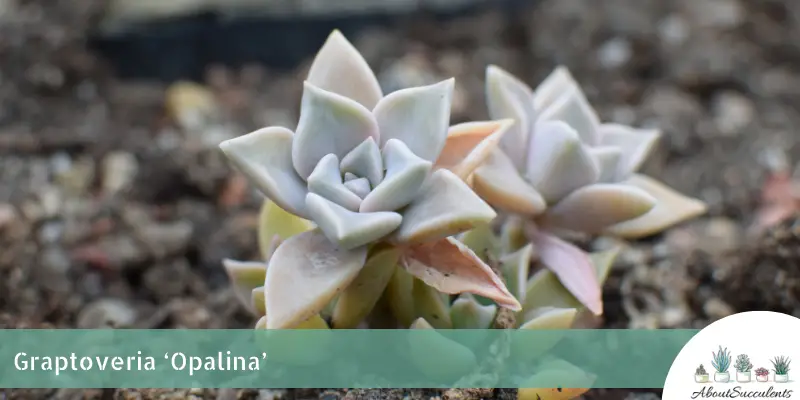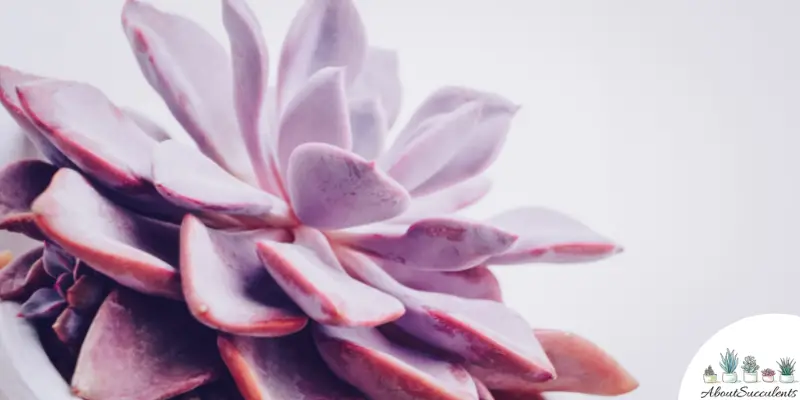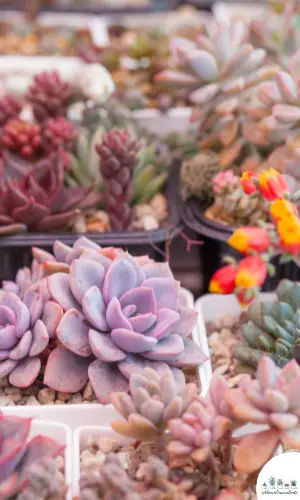
Graptoveria “Opalina” is a succulent that enchants onlookers with its clusters of compact rosettes made of thick, fleshy, and upright blue-green leaves that have accents of pink on its tips and edges.
The rosettes are 6 to 8-inches (15.24 to 20.32cm) tall and 4 to 6-inches (10.1 6 to 15.24cm) wide. In the springtime, you’ll be greeted by charming small, yellow-colored flowers with an orange center.
Opalina was the creation of famed California-based horticulturist Robert Grim in 1988. This variety of succulents is a hybrid of Echeveria colorata var. Colorata and Graptopetalum Amethystium.
Graptoveria Opalina is a perennial evergreen succulent that is native to Madagascar and is a member of the Crassulaceae family.
General Information
Also known as: Opalina
Plant Family: Crassulaceae
Origin: Madagascar
Height: 6 to 8-inches (15.24 to 20.32cm)
Exposure: Partial to full sun will do but to achieve the pink tips and edges, it would be best to give Opalina full sun exposure.
Water Needs: Drought-tolerant; check the level of moisture in the soil. Only water the soil when it’s 100% dry.
Soil Type: Sandy loam with peat moss and gritty soil.
Soil pH: 6.0
How to Grow and Care for Graptoveria Opalina

Graptoveria Opalina is a welcome addition to a rock garden and it will look just as magnificent when housed in a hanging basket. Plant Opalina in a designer container pot and watch it liven any gathering in your home.
Other than its alluring beauty, Graptoveria Opalina has become the choice of many succulent hobbyists because it’s easy to grow and care for.
You need to consider the temperature in your region because Opalina isn’t a cold-hardy succulent. If you have winter season or if mercury falls below 20° F (-6.7° C), it would be a good idea to grow Opalina in a pot that can be moved indoors.
Sunlight
Graptoveria Opalina does well when exposed to partial or full sunlight but in order to get the maximum hue of colors to come out, it would be best to give the succulent direct exposure to the morning sun.
When planting Opalina outdoors, place it in a location that gets 6 hours of full sunlight. This is how you get the leaves to develop the pinkish-red tips and edges. Avoid exposing Opalina to powerful rays of early to mid-afternoon sun as its leaves will be damaged by sunburn.
If you decide to grow Graptoveria as a houseplant, place the pot near a window that gets 6 hours of partial sunlight. To get the succulent to bring out the pinkish tips and edges, put Opalina under a Grow Light for up to 6 hours per day.
Watering

If you want to show Opalina more love, water it less.
Don’t give Graptoveria Opalina water until the soil has completely gone dry. Watering the soil while it still has moisture, will create an ideal environment for fungi growth.
Likewise, keeping Opalina’s roots immersed in moist soil will cause its cells to rupture and provide entry to the fungi.
For this reason, check the level of moisture in the soil before deciding on giving it water. All you have to do is to insert your finger or a stick an inch deep into the soil. If the stick feels dry to the touch, the soil is cleared for watering.
Always water the soil. Don’t water the plant as this will retain moisture longer. When watering, give the soil a thorough drenching.
Pot and Soil
Whether you decide to plant Opalina in a container or a hanging basket, the most important consideration is drainage. The faster the soil dries out the better for Graptoveria.
A pot made of unglazed ceramic or terracotta is the most ideal for Opalina because these types of materials support soil aeration and allows moisture to escape faster.
Get a pot that’s slightly bigger than the base of the plant to allow the roots to grow comfortably. Make sure the pot has a drain hole at the bottom to remove excess water.
Graptoveria Opalina needs gritty, well-draining soil to thrive. The best choice would be sandy soil that’s mixed with peat moss and topsoil.
How to Propagate Graptoveria Opalina
Can’t get enough of Graptoveria Opalina’s enchanting appeal? You can propagate the species using these 2 methods: Stem cuttings or offsets.
Stem Cuttings Method
Step 1: Choose a healthy section of the stem and cut a small part; roughly half an inch with a sterilized and sharpened knife.
Step 2: Place the cuttings in a dry area for 2 to 4 days or until they develop hard calluses.
Step 3: Fill a pot with sandy soil and place the stem cuttings on top of it.
Step 4: Lightly moisten the soil with water and position the pot near a window that gets partial sunlight for up to 6 hours.
Step 5: Once the roots have taken hold, only give water when the soil has completely dried out.
Offsets Method
Step 1: Gently pull out the offsets or pups that are growing near the base of Graptoveria Opalina.
Step 2: Allow the offsets to grow calluses over a period of 2 to 4 days.
Step 3: Plant the callused offsets on a bed of well-draining sandy soil.
Step 4: Water the soil a bit and situate the pot near a window that receives 6 hours of partial sunlight every day.
Step 5: If the roots have formed, water the soil when you’ve confirmed that it has gone 100% dry.
Frequently Asked Questions
Is Graptoveria “Opalina” Toxic to Cats and Dogs?
Graptoveria Opalina isn’t included in the list of plants toxic to cats and dogs that appear on the website of the American Society for the Prevention of Cruelty to Animals (ASPCA).
Why Is My Graptoveria “Opalina” Dying?
Love can kill Graptoveria Opalina.
If you can’t resist showing affection to Opalina by giving the soil more water that it needs, the end result will be a crime of passion.
And it’s not only you who show Opalina too much love. Pests are attracted to this succulent and will be the death of it unless you act right away.
Overwatering
If you notice yellowish-brown spots appear on the leaves and stems of Opalina, remove them immediately with a sharpened and sterilized knife. These spots are proof the fungi have found their way inside the plant.
Pull out Graptoveria from its pot and cut off all of the infected roots then let it dry out in a clean area. Remember to sterilize the knife with 70% isopropyl alcohol after each use.
Prepare a new pot by pouring fresh, well-draining soil. Replant Opalina and give it a few days before watering the soil.
Pest Infestation
Mealybugs and aphids will make Opalina their new home. By freeloading on your precious succulent plant, these pests will help themselves with Opalina’s nutritious soil.
If you notice white, cotton-like substances on the leaves of your succulents, these are from mealybugs. If you don’t remove them right away, these substances can infect Opalina.
Wipe away these substances with a cotton ball that’s soaked in 70% isopropyl alcohol.
Yes, Graptoveria Opalina produces small, yellow-colored flowers that have an orange center in the springtime.
Last Updated on June 9, 2022 by Sofia Lara